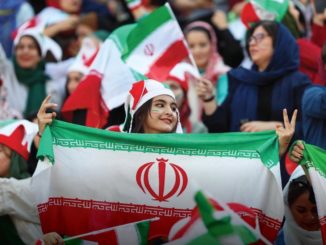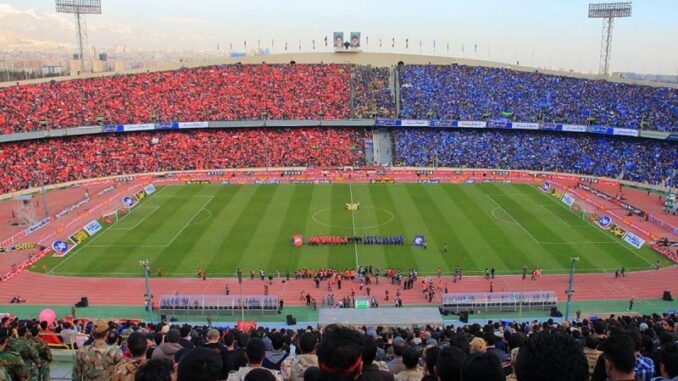
There are lots of insults and obscenities among Iranian football fans but none of them couldn’t compare with “Team-e-Hokoumati” which means ‘Team of the Regime’.
After Iran’s Islamic revolution in 1979, this term had vanished for more than three decades but Persepolis’ dominance of the Iran Pro League and their five consecutive titles urged the fans of rival sides, especially Esteghlal and Sepahan, to rehash the term “Team-e-Hokoumati”.
But Persepolis’ fans have their reasons to dismiss this claim and believe Esteghlal’s fans are simply trying to hide their past.
Doucharkheh Savaran, Taj, Parviz Khosravani and others
The Islamic Revolution changed many things in Iran, including the name of its football clubs.
The new rulers wanted to eliminate all signs of Pahlavi regime and they couldn’t tolerate that the name of the most popular football clubs be Taj, meaning Crown, and Persepolis, the palace of Achaemenid Empire where Mohammadreza Pahlavi held a 2500-year celebration of the Persian Empire five years before he was overthrown.
So Taj became Esteghlal, meaning independence, and Persepolis turned to Piroozi, meaning victory, two popular term of the revolutionaries.
But it wasn’t the first time that the name of blue side of Tehran was changed. Actually they weren’t even a football team at first.
The club was born as cycling club called Doucharkheh Savaran (bicycle riders) in 1944, but just two years later due to the soaring interest of football in Iran, they decided to add football to their club. Among the founders of Doucharkheh Savaran was a young army general named Parviz Khosravani, who with greater ambition to expand than the other founders, bought their shares and became the club’s owner in 1949.
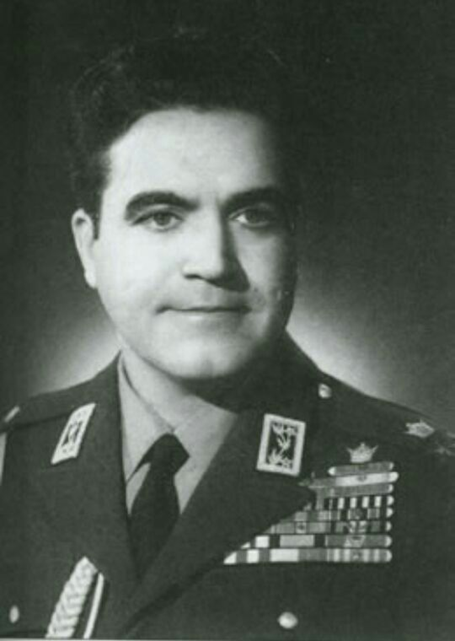
A year later when Afghanistan invited Iran for a friendly match on their independence day, due to lack of preparation for Team Melli, Doucharkheh Savaran became Iran’s representative and they beat Afghanistan 3-2.
After the match the team met Mohammadreza Pahlavi and Iran’s young Shah was perplexed as to why a football team was named Doucharkheh Savaran. It’s said one of players, Mohammad Khatami, who became Shah’s brother in law a couple of years later, suggested that Taj would be good choice and Shah agreed.
Since then Taj became a synonym for the monarchy and it helped Khosravani to make his dreams a reality. In addition to having male and female teams of several other sports, Taj’s founded sister clubs in Rasht, Shiraz, Masjed Soleiman, Tabriz, Khorram Abad, Hamedan and Gonbad-e-Kavoos, with infrastructure that was unprecedented in Asia.
As an influential army general, Khosravani also played a role in the 1953 coup and 1963 suppression but it was a footballing brawl that consolidated the tag of ‘Team of the Regime’ for Taj.
In those years, one of the main rivals of Taj was Shahin, which was founded by a teacher named Abbas Ekrami. He studied in England and had very close relationship with FIFA president Sir Stanley Rous.
Ekrami had very strict criteria to acquire players. With a slogan of “first ethics, second education, third sport”, he only signed players who had an academic education.
Shahin won Tehran League in 1965 but three years later, the club disbanded after Ekrami’s confrontation with Football Federation president Hossein Soroudi.
Soroudi was among Taj’s founders, but left the club because of enmity with Khosravani. He and Mohammad Khatami had a fundamental role in Shahin’s disbandment, but for Shahin fans, who usually were chanting against Mohammadreza Pahlavi, Khosravani was main culprit, especially when he became the president of Physical Education Organisation a year later and disbanded two other clubs.
After a short period in Paykan, Shahin’s players moved to Persepolis and it was the start a long and heated rivalry.
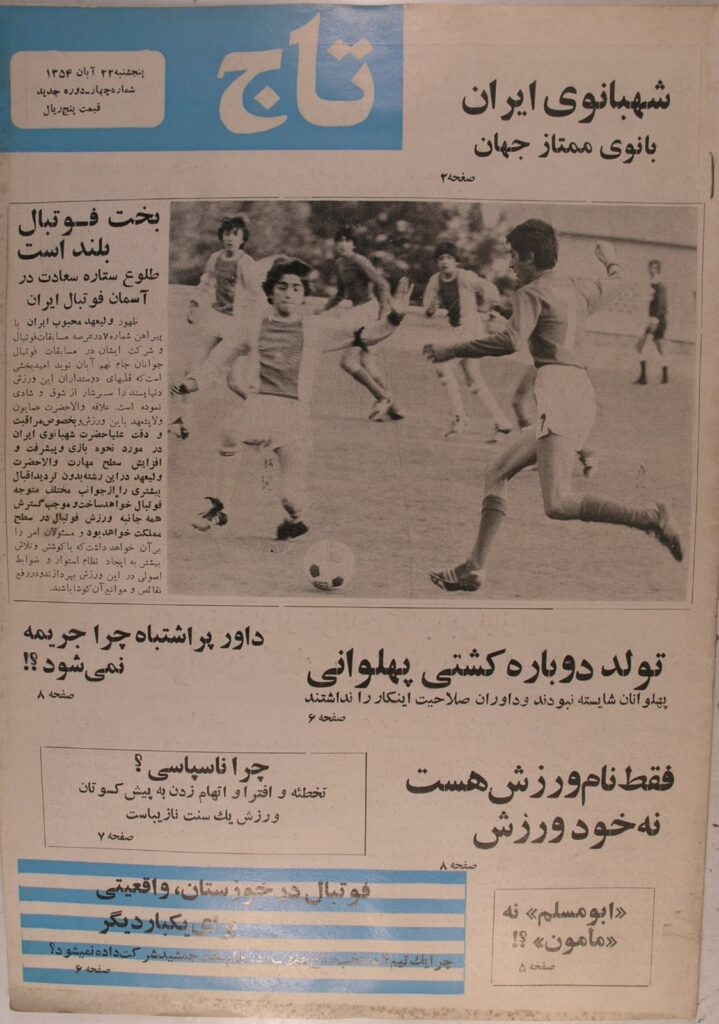
football’s star of luck
Persepolis became the team of the people and Taj the team of the regime. The reality, however, is that neither Shahin or Persepolis were completely independent. Ekrami had high profile jobs in the administration and Ali Abdou, Persepolis founder, was the business partner Shah’s sister, Fatemeh.
There is no doubt about Khosravani and Taj’s links to the Royal Family but others had their connection too. The disbandment of some clubs, including Shahin, was a power struggle among a number of influential army men and even caused huge concern for Khosravani, forcing him to endow the club to prevent its disbandment.
“Daddy Masoud” and the return of Team-e-Hokoumati
After the revolution, the new leaders took everything under their control and football was no exception.
“Esteghlal” and “Piroozi” became part of different organs of state until the Ministry of Sport took over supervision of both clubs around 2010.
As all football clubs in Iran are state-owned and have a “budget” rather than “income”, the common supervisor for the two Tehran giants was based on the idea that a ‘father’ would treat both children the same, ending the long-running debate about their money issues.
But that all changed when Masoud Soltanifar became Minister of Sport in 2016 and during his tenure, Persepolis – they regained their name after three decades when Islamic Republic officials accepted the name is an historical one, but Taj was symbol of the monarchy, although, ironically, The FFIRI president family’s name is Taj) won five domestic titles in a row.
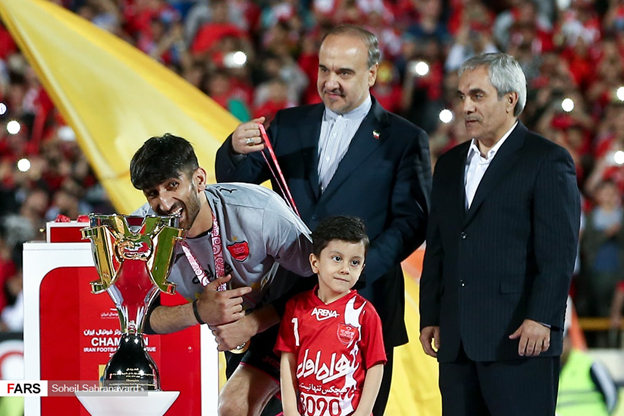
There were rumours that Soltanifar is an ardent Persepolis fan, and with his support Persepolis became Iran’s preeminent side having not won the league for nine years previous.
Persepolis reached final of AFC Champions League, but rival fans also saw this as simply “Daddy Masoud’s” help.
For them, Soltanifar was Persepolis’ father and for others just a step father, especially after former Iran manager Carlos Queiroz claimed that the Ministry of Sport provided more facilities, including a charter flight to Japan for the ACL final, for Persepolis than his side before 2019 AFC Asian Cup.
It wasn’t true and actually was part of his heated brawl with Persepolis manager Branko Ivankovic, but the ‘Team of the Regime’ had returned to the jargon of football fans. This time Persepolis was the beloved child of the administration and all other clubs were against them.
But like 50 years ago, there are obvious reasons to deny it. After nearly a decade of instability, Persepolis found its way to victory under Croatian coach Ivankovic and he was the main reason for the team’s transformation, not the directors, nor Ministry of Sport.
Two years after Soltanifar’s stint ended, Persepolis again won the domestic league this season and have to face Esteghlal in the Hazfi Cup final on Wednesday (18:15 CET).
If they win the double, the fans of other clubs will no doubt try to tarnish their achievement again, but the ‘Team of the Regime’ is more like a joke. In countries like Iran, all teams with a huge fan base are teams of the regime, whether they win trophies or not.
Photo: twitter/PersepolisFC
Listen to the latest episode of The Asian Game Podcast


